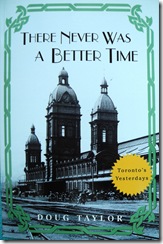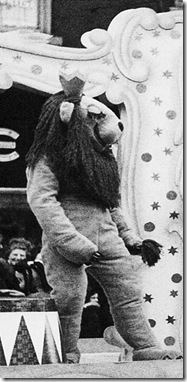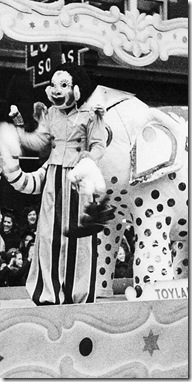City of Toronto Archives, The Globe and Mail Collection, Fonds 1488, Item 6614
 The passage quoted below is from the novel, “There Never Was A Better Time.” It tells about my dad, Jack Taylor, attending the Eaton’s Santa Claus Parade in 1922, with his girlfriend, a young school teacher named Mary Gillard. The previous year, my dad, at age 21, had immigrated to Toronto from a small fishing village on the southeast coast of Newfoundland. In 1921, the rocky isle was not a province of Canada.
The passage quoted below is from the novel, “There Never Was A Better Time.” It tells about my dad, Jack Taylor, attending the Eaton’s Santa Claus Parade in 1922, with his girlfriend, a young school teacher named Mary Gillard. The previous year, my dad, at age 21, had immigrated to Toronto from a small fishing village on the southeast coast of Newfoundland. In 1921, the rocky isle was not a province of Canada.
From the minute my dad arrived in Toronto’s old Union Station (shown on the cover of the book), he was entranced by the city. The book relates his experiences in his adopted homeland. As as child I heard his stories about visiting the sin palaces and burlesque houses of Toronto. Included in his tales was his first time viewing the magical Santa Claus Parade.
Jack and Mary had decided to view the parade on Bloor Street near Ossington, where it would arrive before ten o’clock. The temperature was slightly above freezing, but the air was miserably damp. The grey sky was sullen, covered with dark clouds. Periodically, narrow shafts of sunlight pierced through and brightened the scene. Because of the chill in the air, women pulled their shawls around their shoulders and elderly men turned up their coat collars. Others faced the long wait more impatiently, stamping their feet and clapping their gloved hands to keep warm. Children ignored the elements, pushing back the hoods of their snowsuits or removing their caps. These actions solicited sharp rebukes from their parents. For the adults, the rituals of waiting were indeed trying, but the children were far too excited to share their parents’ concerns.
Finally, the music of a pipe band was heard on the wind. The parade was at last approaching. A few children threw their mitts into the air, gleefully caught them, and tossed them skyward once more. Mothers scolded the youngsters and warned them to keep their mitts on their hands and to secure their scarves tightly. One mother loudly told her small boy, “Keep wrapped up! I’m not telling you a second time!” Other parents smiled at this—they knew that within the next ten minutes, she would tell the lad a sixth, and perhaps a seventh, time. It was all in vain. He was too excited to worry about mitts and scarves. It was his special day.
A father hoisted his young daughter into a tree, seating her between two lower limbs. The location gave her an unobstructed view of the parade. A few other parents held stepladders, perched their tots on the top rungs, and held the ladders securely to prevent people from knocking against them. Others lifted small tots onto their shoulders. Children who remained standing on the sidewalk gazed up in envy, wishing that they, too, had a private tower from which to view the parade.
Then, as if by wizardry, the parade arrived. Applause and cheers erupted as the heralds, dressed in blue and gold livery, trumpeted the inauguration. The colourful musicians were followed by a marching array of beloved nursery-rhyme characters, including Old King Cole and his merry old soul, and Cinderella in her royal coach of gold and silver, with Prince Charming at her side. The “Old Lady in a Shoe” did indeed have so many children that she did not know what to do. There were six bunnies with the ancient, rumpled Uncle Wiggly. It was a dream of fantasy, as magical as it was enchanting.
The skirl of the pipes of the 48th Highlanders stirred the hearts of the adults as much as any fairy-tale character enchanted those of the young. A boys’ bugle band from a local high school played “Good King Wenceslas,” followed by a military band from the Toronto Armouries on University Avenue, which played “Hark, the Herald Angels Sing” on glockenspiels.
Titania and her fairy court arrived next, and then a contingent of toy soldiers, stiff and wooden, marched as if they had recently climbed from a toy-box. The gold buttons on their blue uniforms glittered when a burst of sunlight washed across the parade route. There were marchers dressed as bears, lions, tigers, and donkeys, as well as numerous clowns with exaggerated features, baggy costumes, and funny hats. They cavorted and pranced on floppy, oversized feet. The best-loved of all were the clowns who appeared to be walking on their hands, as if they were upside down. They shook hands with the children and patted small tots on the head. Children surrendered to their charm, and not even adults were immune to the silly antics. With each musical group and character of fable, the magic of Christmas danced into the hearts of Toronto.
Then, in the wink of an eye, the end of the parade was in sight. As Santa arrived in his iceberg motor-car, a shaft of sunlight magically spotlighted the jolly old man. The children hollered and screamed, as if Santa were the only person in the world who knew their secrets and would bring them toys, games, and candies. He was Mister Wonderful. At the parade’s conclusion, he would ascend a ladder and enter the Eaton’s store through a window. He would reside, until Christmas Eve, in Toyland, on the third floor. Late on the twenty-fourth, he would fly in his magical sleigh across the winter sky, delivering toys and gifts to those who had been nice, but not to those who had been naughty. Jack and Mary smiled as they watched the scene. Considering Santa’s rules, they doubted they would be in his good books. They had jokingly decided that being naughty was simply too much fun.
The end of the parade felt like the conclusion of a birthday party. It did not seem possible that the moment had arrived and then just as quickly departed. Everyone had anticipated it so eagerly, and now it was over for another year. The parade was the next best thing to Christmas Day itself, and never lasted long enough to allow a child to feel satisfied.

